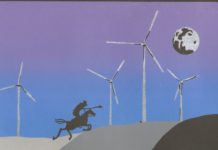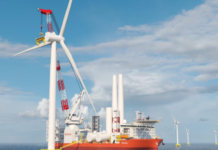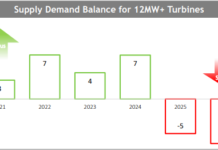Better technology is allowing some wind farm operators to get more out of their existing wind farms by completely repowering the farm – replacing old technology with new – or by conducting performance upgrades on their turbines.
Jennifer Runyon
There is an old piece of wisdom that states: “If it ain’t broke, don’t fix it.” But some wind farm operators, especially in Germany and North America, are finding that advice difficult to heed. That’s because technology improvements in turbines coupled with software analytics are revealing that signing up for a performance upgrade could allow them to squeeze even more wind energy – and money – out of existing wind farms.
Replacing Old Technology with New
According to the recently released Global Wind Report by the Global Wind Energy Council (GWEC), “Repowering has become a billion euro market.” The report shows that in Germany 544 wind turbines with a combined capacity of 264 MW were taken offline in 2014 and replaced by new turbines with a capacity of 1000 MW.
![1505REWRunF-1[1].jpg](http://www.altenergystocks.com/wp-content/uploads/2017/08/1505REWRunF_1_1_.jpg)
The Vestas V100-1.8 MW turbines at Macho Springs Wind Farm in New Mexico, USA. Credit: Vestas.
While repowering “has not become a very substantial market yet anywhere besides Germany, the potential is huge,” said Steve Sawyer, GWEC’s president and CEO. “Especially in places like California, Denmark, Germany, even in India where a lot of the best wind sites are now occupied by, in some cases, comically ancient machines that look like they belong in a museum,” he said. Sawyer predicts there will be much more action in the re-powering market in the coming years.
Performance Upgrades
It isn’t only old technology that is being upgraded, however, sometimes turbines that have been in the field for just four or five years are candidates for an upgrade.
Navigant Consulting’s Jesse Broehl is one of the authors of the recently released World Wind Energy Market Update 2015 published by BTM Navigant. He explained that wind performance upgrades are a recent development where major turbine vendors such as Vestas [VWDRY], Siemens[SIEGY], and GE[GE] (the number 1, 2 and 3 suppliers in 2014, respectively) among others “are looking for every opportunity that they can to diversify their revenue stream and increase their income beyond just turbine sales,” he said. Broehl explained that performance upgrades are taking place on relatively young turbines. He pointed to a deal in which EPD purchased GE’s PowerUp package for 402 turbines spread out over 5 different wind farms. “Maybe those [turbines] are 4 or 5 years old. Probably in that range, maybe even newer,” he said.
Ken Siddall, Director of Service Technology Americas at Siemens said that his company offers its modifications and upgrades packages on turbines that are as little as two years old. He explained that upgrades span the entire power curve. “In low-wind situations, we’ve got a reactive power offering. In the ramp of the power curve, as the wind speeds are coming up, we offer a power-curve upgrade kit, at the top, at full winds, we can offer a power boost to customers with certain turbine models,” he said. Siemens also keeps customers informed about available upgrades to its existing fleet of turbines. “Every year or so Siemens launches new turbines with new upgrades or enhancements for improved power performances and as much as we can we try to bring those back into the existing fleet that’s already out there,” he explained.

Development of the annual installed and cumulative capacity (MW) of land-based wind energy in Germany including repowering and dismantling as of December 2014. Source: Platts Power Vision 2015. Credit: GWEC’s Global Wind Report.
Wille Mildebrath, Product Manager at Vestas likened power performance upgrades to customization on a car. “With traditional maintenance, [you would, for example] change the gear oil,” he said, adding, “you could also do customization of the car and that’s what we’re doing with performance upgrades.” Mildebrath said that Vestas works with customers to do anything it can to customize and optimize the turbines that are already installed in the field.
Vestas performance upgrades take place after the company, in partnership with the wind farm owner, has conducted “a site specific analysis of that turbine to make sure we understand which upgrade or upgrades would be best.” Vestas offers a product suite called PowerPlus, which encompasses power upgrades, extended cutouts, and aerodynamic upgrades, said Mildebrath. “Power upgrades and extended cutouts are most effective on high wind sites, and aerodynamic upgrades have the most impact on low wind sites,” he explained. To date, Vestas has sold PowerPlus upgrades for more than 1,300 wind turbines – less than a year after its public launch.
Data collection and analysis of turbines in the field is a big part of both Vestas’ and Siemens’ offerings. It’s that data analysis that helps Siemens know when it is best for customers to entertain the idea of implementing these modernizations and upgrades. The company is constantly monitoring its entire fleet of turbines, according to Siddall “gathering terabytes of data from all of our turbines onshore and offshore.”

Software plays a big role in upgrades. Improving the software that controls the turbine “is probably the largest part of these performance upgrade packages,” said Navigant’s Broel. He said that better algorithms are able to improve “how the turbine operates and how it reacts to the wind environment it is experiencing.”
Attractive Costs
Since the money to perform an upgrade often comes from a wind farm owner’s O&M budget, rather than the capital expenditure budget, OEMs have made doing them quite enticing. “Vestas PowerPlus is basically free for customers to install,” said Mildebrath. The customer pays for the additional energy produced through a revenue share arrangement that is worked out before the upgrade is installed.

DinoTails can be installed directly on the rotor blades of existing wind turbines. Credit: Siemens.

The offshore Wind Farm Horns Rev in Denmark uses Siemens turbines. Credit: Siemens.
GE has a similar arrangement, said Andy Holt, general manager for global projects/services, GE Renewable Energy. “Our customers pay very little upfront costs to implement our PowerUp services platform,” he explained adding that GE only profits if its customers do. Siddall said that Siemens has a profit split arrangement where the company shares in any increased revenue they might get from the upgrades.
How much more revenue are they going to get? That is dependent on a lot of factors of course, including wind conditions, which upgrade was specified, the site itself etc. However, Siddal, Holt and Mildebrath said that a 5 percent increase in annual energy production (AEP) is a good target. “Up to 5 percent AEP increase is not uncommon,” said Mildebrath.
One Note of Caution?
With no upfront costs, performance upgrades seem to offer what everyone wants: the opportunity to gain more revenue from an existing asset. However Navigant’s Broehl offers one word of caution. “Basically if you run you
r turbine harder then there might be a compromise on its end-of-life use,” he said. “You might be taking away years on the back end in order to get that up-front increased performance.” Broehl cautioned that a tax-equity investor who plans to exit the deal after a certain rate of return has been reached, say in 10 years, and a different organization that will own the wind farm once that investor has left, may have differing financial motivations. “It’s a little bit like how you might prefer to buy a used car from the retirees down the street instead of from a college student,” he said.
Nevertheless, most OEMs are committed to a long-term relationship with their customers. Siddall talked of the 10- and 15-year O&M contracts that Siemens makes with its customers. It seems that any risk of prematurely wearing out a turbine could be mitigated with the right kind of contract in place. “We take a long-term approach to this,” Siddall said.
Jennifer Runyon is chief editor of RenewableEnergyWorld.com and Renewable Energy World magazine, coordinating, writing and/or editing columns, features, news stories and blogs for the publications. She also serves as conference chair of Renewable Energy World Conference and Expo, North America. Formerly, she was the managing editor of Innovate Forum, an online publication that focused on innovation in manufacturing. Prior to that she was the managing editor at Desktop Engineering magazine. In 2008, she won an “Eddy Award” for her editing work on an article about solar trees in Vienna. In 2010, RenewableEnergyWorld.com was awarded an American Business Media Neal Award for its eNewsletters, which were created under her direction. She holds a Master’s Degree in English Education from Boston University and a BA in English from the University of Virginia.
This article was originally published on RenewableEnergyWorld.com, and is republished with permission.







